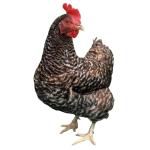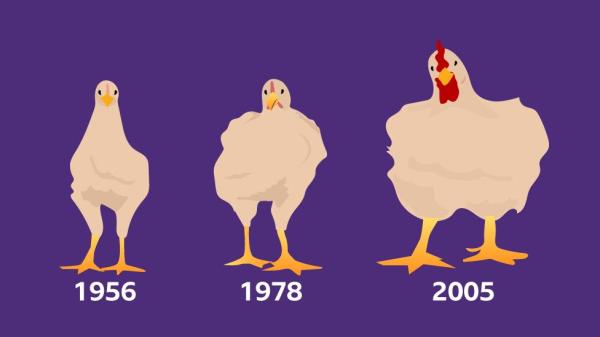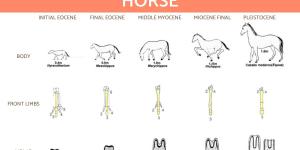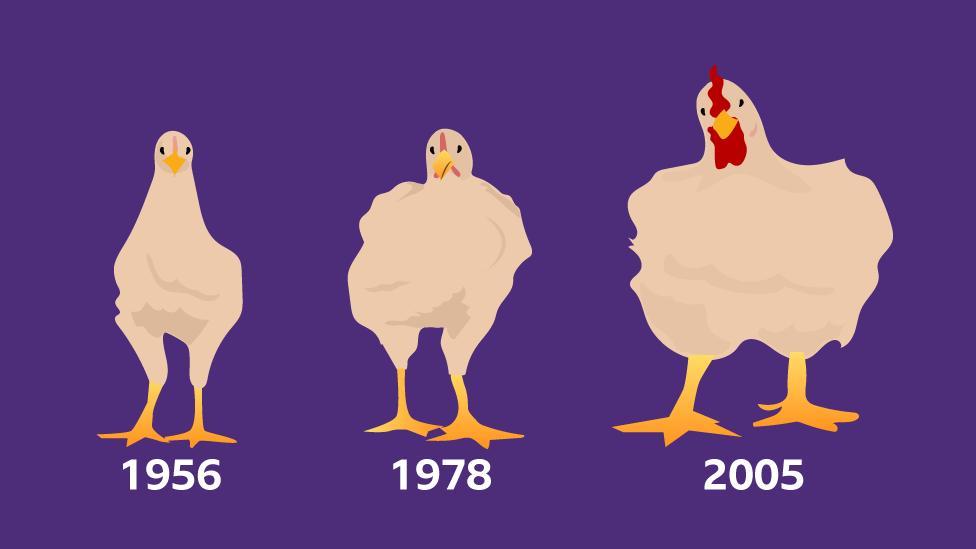The Origins and Evolution of Chickens



See files for Hens and roosters
In the realm of the animal kingdom, few creatures have carved a more significant place for themselves in the annals of human history than the humble chicken. From farmsteads to urban coops, their presence is ubiquitous, and their contributions to our lives are immeasurable. But have you ever wondered how these feathered friends came to be?
The following AnimalWised article explores the origin and evolution of chickens. It examines how the chicken we know today has evolved over thousands of years due to natural selection and human influence.
Did chickens evolve from dinosaurs?
Yes, chickens and all modern birds share an evolutionary ancestry with dinosaurs. Specifically, they are believed to have evolved from a group of dinosaurs known as theropods, a group of bipedal, carnivorous dinosaurs that included renowned species such as Velociraptors and the Tyrannosaurus rex. This connection between birds and dinosaurs is supported by fossil evidence, genetic studies, and anatomical similarities.
Throughout millions of years, this shared lineage underwent a profound transformation, giving rise to various branches of theropods. These diverse branches ultimately paved the way for the emergence of modern birds. It's worth emphasizing that this evolutionary journey was marked by a multitude of transitional forms and an array of trait changes that unfolded over time.
In other words, while chickens themselves did not directly evolve from famous dinosaurs like Velociraptors or Tyrannosaurus rex, they share a common ancestor with these dinosaurs in the broader lineage of theropod dinosaurs.
In this context, Archaeopteryx assumes a pivotal role as a tangible representation of one of these transitional forms within the broader evolutionary canvas. Possessing a unique blend of characteristics, Archaeopteryx exhibited both dinosaur-like and bird-like features. It boasted feathers akin to those found in contemporary birds, hinting at the capacity for gliding or flight. Intriguingly, it retained certain dinosaur-like traits, including teeth in its beak and a lengthy, bony tail—features absent in modern birds.
Be sure to explore our article on living and extinct prehistoric birds for deeper insights on the evolution of birds.
Evolution and domestication of modern chickens
Chickens, spanning from their ancient forebears to the varied domestic breeds we recognize today, have undertaken a fascinating journey, influenced by the intricate interplay of natural selection and human-guided selective breeding.
The domestication of wild animals stands as a significant milestone in human civilization's journey. Over the course of history, about 40 different animal species have been successfully domesticated. Many of these domesticated animals continue to play essential roles in agriculture and food production to this day. Among these domesticated creatures, the chicken is exceptionally widespread, serving dual purposes as a valuable source of both eggs and meat.
The tale begins with prehistoric birds that roamed the expansive landscapes of Asia and Africa over millions of years. These ancestral birds underwent gradual transformations, gradually acquiring key traits that would later become synonymous with the domestic chicken. Notably, they sported the distinctive fleshy crest on their heads and a body structure perfectly suited for life on land.
As the eons rolled by, the paths of birds and humans converged, marking the tentative beginnings of domestication. Across diverse ancient cultures worldwide, chickens started to be raised and nurtured for their invaluable eggs and delectable meat. Simultaneously, the subtle forces of nature played their part, favoring birds with attributes that made them well-suited for coexistence with humans.
However, the pivotal moment in the chicken's evolutionary narrative came with the advent of selective breeding. Over centuries, humans consciously paired chickens with specific desired traits. Whether it was a penchant for prolific egg-laying, substantial size, or mouthwatering meat, these human-guided choices began to mold the trajectory of chicken evolution. This meticulous process gave rise to a diverse array of chicken breeds, each uniquely adapted to fulfill distinct human needs.
In more recent times, the wonders of genetics have accelerated the pace of selective breeding, ushering in the creation of highly specialized chicken breeds. Today, we encounter chickens that have been painstakingly bred for optimal meat production, prolific egg laying, ornamental exhibition, and even cherished companionship.
The story of chicken evolution remains far from static; it continues to unfold as dedicated breeders and scientists collaborate to further refine these birds' traits and enhance their adaptability in an ever-changing world.
For more information about how do chickens mate and reproduce, as well as chicken egg hatching process, keep reading this other article.
[Image](https://www.bbc.com)

Which came first: the chicken or the egg?
The classic question of whether the chicken or the egg came first taps into the intriguing world of evolution. In the realm of biology, species don't suddenly change overnight; it's a gradual process that takes place over many generations.
So, how did chickens come into existence? The answer lies in a slow and steady journey of evolution driven by genetic changes. Speciation, or the emergence of a new species, typically happens due to small tweaks in DNA that accumulate over time. These genetic variations get passed down from one generation to the next, building up within a population over many, many years.
The earliest traces of bird domestication that resemble our modern-day chickens can be traced back to ancient China, approximately 8,000 years ago. During this ancient epoch, the process of domesticating birds was already in full swing. Among these early domesticated birds in China was the red junglefowl (Gallus gallus), considered a precursor to the chickens we recognize today as Gallus gallus domesticus.
The rapid and extensive distribution of chickens was primarily facilitated by their capacity to offer a source of both meat and eggs without competing for essential human food resources. However, it is widely believed that the widespread practice of cockfighting played a pivotal role in the dispersion of chickens.
These early avian counterparts exhibited some resemblances to the chickens we know today, yet they differed in terms of size and specific characteristics. It was through the patient practice of selective breeding that these early domesticated birds underwent a transformation.
It's crucial to understand that there was no specific moment when a non-chicken bird suddenly laid an egg, and a chicken emerged. Instead, the transformation from non-chicken to chicken happened slowly, through countless generations of small genetic and evolutionary tweaks. This patient, step-by-step process is how chickens, like many other species, came into existence.
Explore this other article for a comprehensive understanding of why hens can't fly.
How are chicken breeds formed?
Chicken breeds are formed through selective breeding, a process where humans intentionally choose chickens with specific desirable traits and mate them to emphasize those traits in their offspring.
This deliberate breeding and selection set in motion the expansion and development of specific features that laid the foundation for what we now identify as distinct chicken breeds.
The time it takes for a new chicken breed to emerge can vary widely. It typically depends on how quickly the desired traits are stabilized and standardized. Some breeds may take several decades or even centuries to develop, while others with less stringent criteria may emerge more rapidly.
How many breeds of chicken exist today?
There are hundreds of recognized chicken breeds worldwide, with the exact number varying by country and region. These breeds serve various purposes, from egg and meat production to ornamental and heritage preservation. While some are well-known internationally, many others are locally or regionally specific.
Poultry organizations and breed clubs in various countries maintain breed standards and official recognition for different chicken breeds. The American Poultry Association (APA) and the American Bantam Association (ABA) in the United States, for example, officially recognize and standardize numerous chicken breeds and varieties. Similarly, organizations like the Poultry Club of Great Britain do the same in the UK. The Food and Agriculture Organization of the United Nations (FAO) also keeps records of various chicken breeds around the world.
You might be interested in this other article that explores the distinctions between pheasants, quails, and chickens.
If you want to read similar articles to The Origins and Evolution of Chickens, we recommend you visit our Facts about the animal kingdom category.
- Al-Nasser, A., Al-Khalaifa, H., Al-Saffar, A., Khalil, F., Albahouh, M., Ragheb, G., ... & Mashaly, M. (2007). Overview of chicken taxonomy and domestication. World's Poultry Science Journal , 63 (2), 285-300.
- Dorji, N., Duangjinda, M., & Phasuk, Y. (2012). Genetic characterization of Bhutanese native chickens based on an analysis of Red Junglefowl (Gallus gallus gallus and Gallus gallus spadecieus), domestic Southeast Asian and commercial chicken lines (Gallus gallus domesticus). Genetics and molecular biology , 35 , 603-609.
- Miao, YW, Peng, MS, Wu, GS, Ouyang, YN, Yang, ZY, Yu, N., ... & Zhang, YP (2013). Chicken domestication: an updated perspective based on mitochondrial genomes. Heredity , 110 (3), 277-282.
- Woldekiros, HS, & D'Andrea, AC (2017). Early evidence for domestic chickens (Gallus gallus domesticus) in the Horn of Africa. International Journal of Osteoarchaeology , 27 (3), 329-341.






